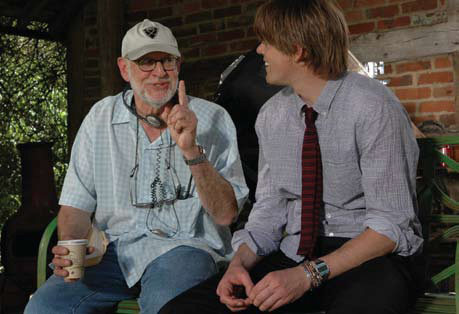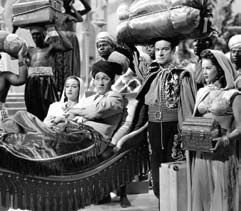BY FRANK OZ
 Frank Oz (on the set of Death at a Funeral) says if you
Frank Oz (on the set of Death at a Funeral) says if you
want spontaneity you have to open to accidents.I make a deal with the audience every time I direct a movie. The deal always is this: I’m showing you this world in which the characters live. The world I’m creating has rules. My tacit agreement with you is that I promise I will stay true to the rules of that world. In exchange for this promise I need you to completely buy into that world.
So if I’m making a heist movie, as I did with The Score, I can’t have Robert De Niro’s character turn to the camera and suddenly start singing. But with the Road movies, Bob Hope and Bing Crosby could do just that. They were saying to the audience, “OK, here’s the deal: We know this is stupid, and since it’s stupid, let’s just screw around. We know Zanzibar and Morocco and Singapore are really on the back lot in Los Angeles, and you know it too. So let’s go with it!” And the audiences did.
Hope and Crosby made seven Road movies, starting in 1940 with Road to Singapore. The movies were always about Crosby and Hope fleeing America and finding Dorothy Lamour in some exotic location. Bob’s character was cocky and cowardly; Bing’s character was smooth and unruffled. They were great characters - lousy, lovable guys.
In Road to Morocco (1942), Bing sold Bob to get some fast cash. Now that’s a big comedic risk, selling your friend to someone to get a few hundred bucks. In Road to Rio (1947), Bob falls from a tightrope but manages to hang on at the last second. He looks into the camera and says, “This picture could end right here.” And, at another point in Morocco, a camel turns to the camera and says (with an animated mouth), “This is the screwiest movie.” And it was. If they had wanted to, Hope and Crosby could have left their “exotic” sets and, with the camera following, walked outside, jumped on an elephant, gone a few hundred yards, gotten off the elephant, tied it up, and entered a restaurant to have lunch. It might not have been a good decision for the movie, but it would all have been true to their world, true to the deal they’d made with the audience.
If the director (Victor Schertzinger on Singapore and Zanzibar, David Butler on Morocco) had wanted that elephant/restaurant scene, it would have required planning - deep planning. And the 1st AD would have to figure out the permits to get outside the lot, where to get the elephant, how long it would take, crowd control, and all that stuff you do in prep in order to make it look like it’s not prepped. But it would not have been necessary to explain why they jumped on that elephant. They could have just looked at the camera, thrown in a comedy line commenting that it was lunchtime, and the audience would have accepted it. The rule for the Road movies was that there were no rules. What freedom!
 NOT MARRAKECH: Dorothy Lamour, Bing Crosby,
NOT MARRAKECH: Dorothy Lamour, Bing Crosby,
Bob Hope and Dona Drake in Road to Morocco.But it was a very disciplined freedom. It wasn’t a freedom of, “Hey, fuck it, we can just do whatever we want.” It was a freedom born out of professionals knowing how to enhance a structure, a character, a motivation, a joke, a mood. There’s a scene in Road to Morocco, it’s kind of famous, where a camel spits in Hope’s face. It wasn’t planned; the camel did it of its own accord while the cameras were rolling. Bing laughs and Bob recoils - he doesn’t know what the hell to say. Their reaction was so spontaneous, the director left it in the final cut. If you’re a director who wants spontaneity in your movie, you don’t just look for what’s in the script; you look for the stuff outside of the script to enhance what’s written. You look for the wonderful accidents. Now, of course I wasn’t there for the filming, but I imagine the directors on those Road pictures were studio pros who were trying to make their days, but were also open to playing around. There’s a story about how on a lunch break during the shooting of Road to Singapore Hope threw a handful of soapsuds at Lamour and soon Crosby joined in. The fight ended when Lamour cornered Hope and Crosby and threw all she had at them. The director supposedly was not particularly pleased because it would take hours to repair their hair, makeup, and clothing. But if the director was intent on getting his finished product, he might also have been thinking, “There goes the schedule for the day, but this is more important.”
I mean, what would happen to the comedy in the next takes if the director went up to Hope and Crosby and said, “OK, you’ve got to stop, we’ve got to shoot?” I have been in many similar situations. On Dirty Rotten Scoundrels, Michael Caine, Glenne Headly, and I were just laughing so much for half an hour we couldn’t shoot. I didn’t care; I thought that was great. I know you’ve got to make the schedule and you’ve got to save money, but it was more important to allow and support that buoyant mood because it would get me better comedic work.
And I knew in my head, “Ok, I’ll make up for this time someplace else.” What I remember most about the Road movies is my enjoyment at watching the two characters sparring with each other. But more important than that was my feeling that Hope and Crosby were enjoying the sparring too. What I glean is that Bob and Bing trusted each other so much they could ad-lib and then go right back to the story without missing a beat.
Their ad-libs were not out of the story, but were part of it and part of the deal made with the audience. That’s why they worked so well. The Road movies were stupid, but they were smart-stupid. You have to be smart to break the form and support that much silliness. That’s what I sensed when I saw them. Although the rest of the audience probably didn’t care. They just wanted to laugh.